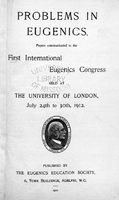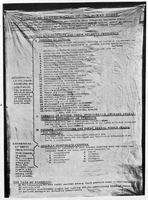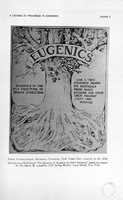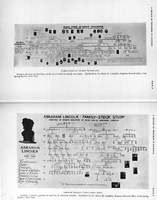Controlling Heredity
International Eugenics Congresses

Problems in Eugenics: Papers Communicated to the First International Eugenics Congress.
London: Eugenics Education Society, 1912.
Depository 575.6 In8 1912

Problems in Eugenics: Papers Communicated to the First International Eugenics Congress.
London: Eugenics Education Society, 1912.
Depository 575.6 In8 1912

Scientific Papers of the Second International Congress of Eugenics.
The Second International Exhibition of Eugenics.
Baltimore: Williams & Wilkins, 1923.
Depository 575.6 In8 1921s

Scientific Papers of the Second International Congress of Eugenics.
The Second International Exhibition of Eugenics.
Baltimore: Williams & Wilkins, 1923.
Depository 575.6 In8 1921s

A Decade of Progress in Eugenics.
Baltimore: Williams & Wilkins, 1934.
Depository 575.6 In8 1932d
University of Missouri Libraries
University of Missouri

A Decade of Progress in Eugenics.
Baltimore: Williams & Wilkins, 1934.
Depository 575.6 In8 1932d
University of Missouri Libraries
University of Missouri
The heart of the eugenics movement shifted to the United States from Britain in the first three decades of the twentieth century. This relocation is demonstrated by the three International Eugenics Congresses of 1912, 1921, and 1932.
The 1st International Eugenics Congress was held in London and presided over by Charles Darwin’s son, Major Leonard Darwin. The Congress and its activities were dominated by Galton’s and Pearson’s adherents.
After the Great War, the 2nd International Eugenics Congress was held in 1921 at New York’s American Museum of Natural History. The Congress was presided over by Henry Fairfield Osborn with Alexander Graham Bell as its honorary president. In excess of 75% of all papers delivered at the congress were by American participants.
The 3rd International Eugenics Congress in 1932 was also held at the American Museum of Natural History and the president of the congress was Charles Davenport, Director of the Cold Spring Harbor Laboratory and founder of the Eugenics Record Office. Ernst Rudin, soon to be author of the German 1933 Law for the Prevention of Hereditarily Diseased Offspring, was unanimously elected president of the International Federation of Eugenic Societies at the end of the Congress.
Figure 4, plate 67 (below) is a cloth chart displayed in the Hall of Exhibits of the 2nd Eugenics Congress in 1921, entitled Eugenical Classification of the Human Stock. The chart, created by the Eugenics Record Office, lists the best eugenic traits that make up the superior human and links them with outstanding individuals that were preeminent in their fields of activity. The chart also shows characteristics of the "eugenically unfit" that were thought to be products of defective inheritance who dragged down society and the human race.
Plates VIII and IX below show the family pedigrees of George Washington and Abraham Lincoln as posted in the Hall of Exhibits at the 3rd Eugenics Congress in 1932. The creation of pedigrees of famous and important people became a fashion, and its prevalence at the Eugenics Congress of 1932 demonstrates that eugenicists were not too far removed from the ideals and methods of Francis Galton.
Compare the logo of the 2nd International Eugenics Congress with that of the 3rd Congress. Both use a tree as a symbol of the eugenic enterprise (family tree), but the 1932 logo includes many more and increasingly complex roots. The 1921 tree appeared on the certificates awarded to “meritorious” exhibitition entries. The 1932 tree was displayed at the entrance into the exhibition space.